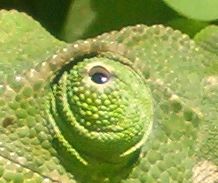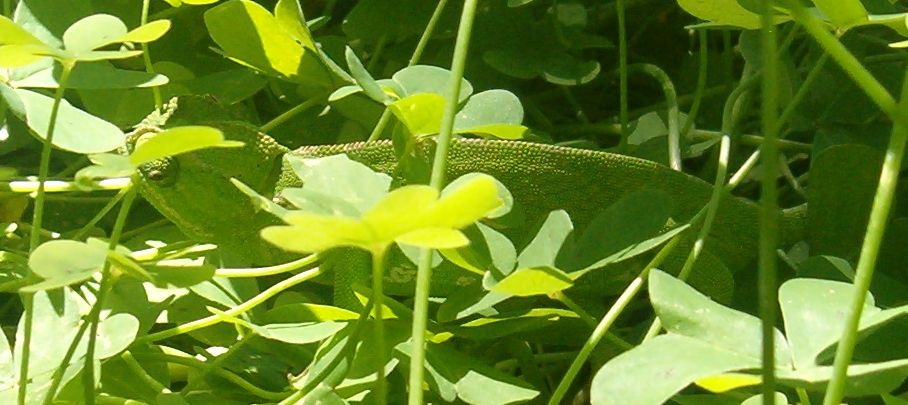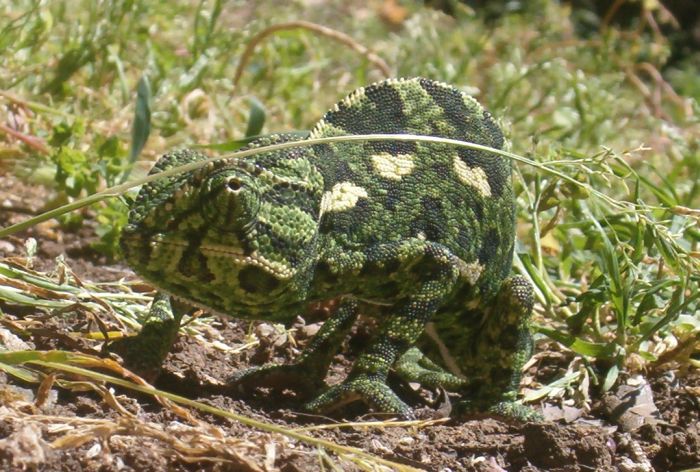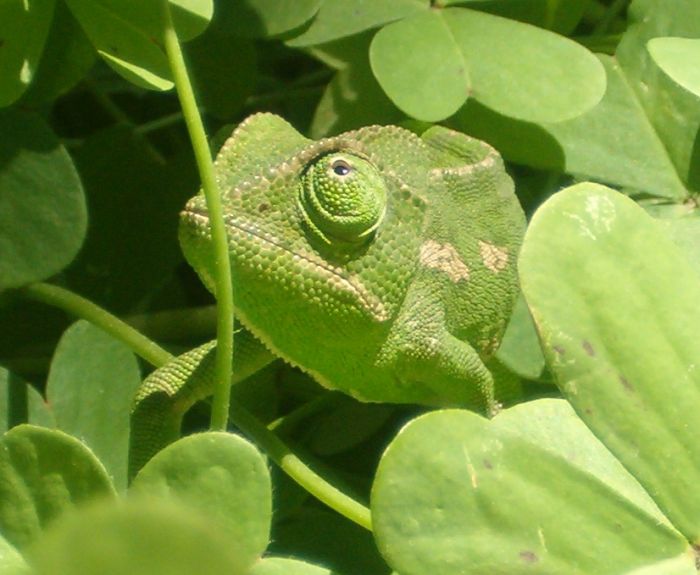Chameleons belong to a family of lizards called the Chamaeleonida. This family of about 160 species is most famous for their ability to change color, although there are several species of chameleons that lack the ability. However, all chameleons are slow animals that have feet specialized for holding on to narrow branches with three fused toes on one side and two on the other; all have remarkable tongues which are sometimes longer than the length of the animals themselves, and shoot out of their mouth to catch unsuspecting prey on the sticky tip; and all have eyes that can each move independently of each other giving a 360 degree field of vision and an ability to detect multiple prey or threats.

Several years ago, before my son Daniel was a teenager, we were driving home when he yelled, “look at that toy dinosaur”. I saw what looked like a bright green plastic lizard and pulled over to get it. The “toy” lizard was actually a living chameleon swaying from side to side in the middle of the road as if it were having an anxiety attack. Daniel and I stopped the traffic, carefully picked up the chameleon, and carried it to a bush across the street. We watched it slowly climb up a branch and suddenly turn brownish. After we turned around for a minute to talk with a passer by, we couldn’t find the chameleon anywhere when we looked for it again. Chameleons are slow, so it was surely still there, however, it was so well camouflaged that we couldn’t distinguish it from the background no matter how hard we looked.

The species of chameleon we saw on the street in

It is clear from watching these lizards that their color change is used for camouflage, both so unsuspecting prey will come within their reach and to avoid becoming prey themselves, but recently chameleon’s mastery of camouflage was shown to be more remarkable then previously thought. A group of scientists led by Devi Stuart-Fox at the University of the Witwatersrand,

To capture prey the chameleon sways like a leaf on a branch, perfectly camouflaged against its environment and waits. The chameleon then spots a likely victim, usually a fly or other insect, with one of its eyes, but it is not possible to get depth perception with only one eye, so it then swivels its other eye in the same direction to get the binocular vision necessary to aim properly. Then the tongue is blasted out at the prey as far as one and a half times the body length of the lizard at speeds up to 1800 kilometers per hour (faster than the speed of sound). Jurriaan H. de Groot and Johan L. van Leeuwen from
Interestingly, one of the important predators on the common chameleon is the common chameleon: they can be cannibals. Tammy Keren-Rotem of
Chameleons don’t change color only for camouflage, they also use color to communicate with each other. Mariano Cuadrado from the Estacion Biologica de Donana, CSIC in
Next time you look at a field of bushes and trees think of the many chameleons that are waiting patiently for their next meal while hidden in plain sight.
Further
de Groot, J. H. and van Leeuwen, J. L. 2004. Evidence for an elastic projection mechanism in the chameleon tongue. Proc. R. Soc. Lond. B
Keren-Rotem, T., Bouskila, A., and Geffen, E. 2006. Ontogenetic habitat shift and risk of cannibalism in the common chameleon (Chamaeleo chamaeleon)Behav Ecol Sociobiol 59: 723–731
Ott, M., Schaeel, F., and Kirmse, W. 1998. Binocular vision and accommodation in prey-catching chameleons. J Comp Physiol A. 182: 319-330
Stuart-Fox, D., Moussalli, A. and Whiting, M. J. 2006. Camouflage and colour change: anti-predator responses to two predators across multiple populations in a dwarf chameleon. Biological Journal of the Linnean Society 88: 437-446.
Stuart-Fox, D. M. and Johnston, G. R. 2005. Experience overrides colour in lizard contests. Behaviour. 142: 329-350.